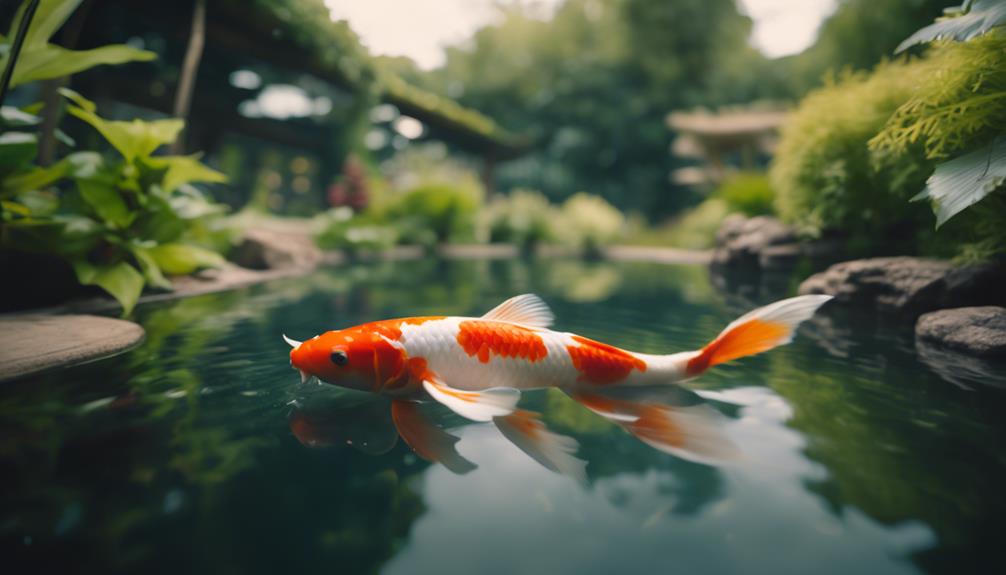You'll need a well-planned and meticulously maintained environment to successfully breed koi. Start by selecting healthy breeding stock, choosing mature koi with desirable traits and feeding them a high-protein diet to improve fertility. Create a pond with a minimum capacity of 3,000 gallons, a filtration system, and adequate aeration to maintain ideal water quality. Monitor and adjust water parameters, perform regular water changes, and remove waste and debris to prevent decay. By following these steps, you'll be well on your way to creating a thriving environment for your koi. But there's more to achieving perfect breeding conditions – you'll want to explore further to guarantee success.
Table of Contents
Key Takeaways
- Create a pond with a minimum capacity of 3,000 gallons, 4 feet deep, and 12 feet wide for ideal breeding conditions.
- Implement a filtration system with 1-2 pounds of bio-media per 100 gallons of water to handle biological load.
- Maintain water temperature between 68-74°F (20-24°C) and ensure adequate aeration with 1-2 air stones per 100 gallons.
- Perform regular water changes of 10-20% every week to maintain ideal water quality and prevent toxin buildup.
- Introduce beneficial bacteria to break down waste and maintain a healthy ecosystem with sufficient space for fish.
Selecting Healthy Breeding Stock
When establishing a koi breeding program, this is vital to select healthy breeding stock as the foundation of your operation, as this decision will markedly influence the quality of your offspring.
You want to select koi of the same species to increase the probability of producing high-quality offspring.
When selecting the koi, choose mature koi that are at least 3 years old, as they're sexually mature and can produce healthy offspring. Look for healthy koi with desirable characteristics such as vibrant colors, patterns, and body shape.
These traits will be passed on to their offspring, ensuring a strong and healthy brood.
You can either purchase breeding stock from a reputable breeder or select from your existing stock. Regardless of the source, make sure to feed your breeding stock a high-protein diet for several weeks before breeding to improve fertility.
Providing Optimal Pond Conditions
To guarantee successful koi breeding, you must provide a stable and healthy environment by creating a pond that meets specific conditions, including adequate size, filtration, temperature control, aeration, and regular water changes.
Your breeding pond should have a minimum capacity of 3,000 gallons, with a recommended size of 4 feet deep and 12 feet wide to allow for adequate water circulation and filtration.
A filtration system capable of handling the biological load of the koi is vital, with a minimum of 1-2 pounds of bio-media per 100 gallons of water.
Water temperature should be maintained between 68-74°F (20-24°C) for ideal breeding conditions, with a gradual temperature increase of 1-2°F (0.5-1°C) per day to stimulate spawning.
Adequate aeration is also essential, with a minimum of 1-2 air stones per 100 gallons of water to maintain dissolved oxygen levels above 5 ppm.
Regular water changes of 10-20% every week are necessary to maintain ideal water quality and prevent the buildup of toxins.
Understanding Koi Breeding Process
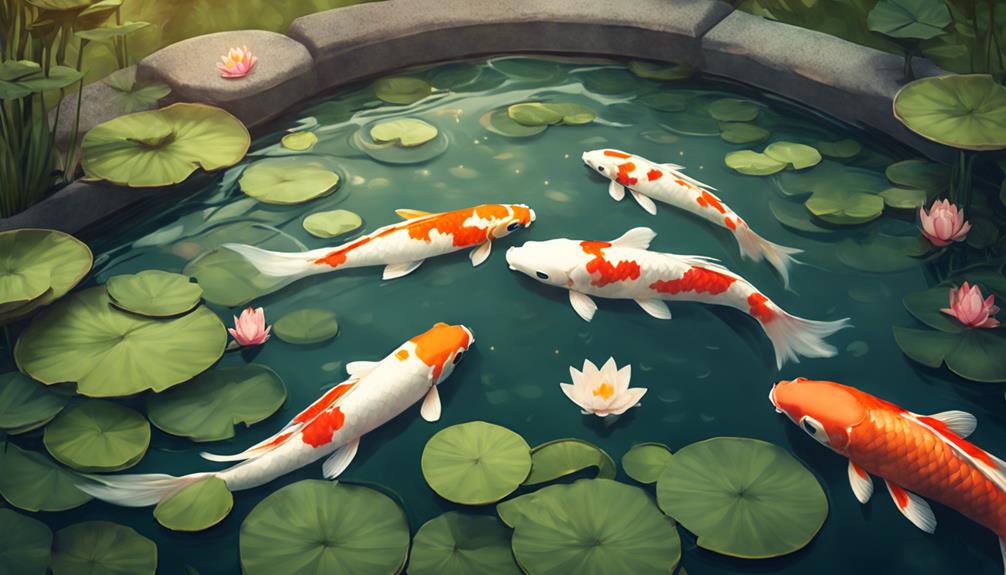
You've created an ideal environment for your koi to thrive, and now it's time to understand the intricacies of the koi breeding process, which is influenced by water temperature and seasonal changes.
As a koi fish breeder, you should know that breeding koi fish typically occurs in late spring or early summer when water temperatures are between 65°F to 70°F.
During this time, males will chase females, nudging their sides with their mouths and fins to encourage egg-laying, and then fertilize the eggs.
As a successful koi fish breeder, you must be prepared to handle potential issues such as infertile eggs, weak fry, or diseases.
You can opt for artificial spawning or natural breeding, but either way, you'll need to remove dead eggs or fry regularly to maintain prime water quality.
Fertilized eggs will hatch into fry in about three to seven days, and it's vital to monitor the breeding process closely.
Hatching and Raising Fry
As you begin hatching and raising your koi fry, you'll need to focus on three critical areas: providing essential care, establishing a feeding schedule, and protecting them from predators.
You'll want to create a safe and nurturing environment that meets their unique needs, ensuring they grow strong and healthy.
Fry Care Essentials
Manage the hatching process carefully, because fertilized eggs will begin to hatch into fry in as little as three to seven days.
You'll need to provide a safe environment with plenty of hiding spaces to prevent predation.
As the koi fry grow, you'll need to focus on their care essentials. Regular water changes and monitoring of water quality are vital for their health and well-being. You should aim to change about 10-20% of the water daily to maintain ideal water quality.
Aeration and low lighting are also beneficial for the development of the fry.
You'll need to monitor them regularly to prevent diseases, parasites, and infections.
With proper care, your koi fry will thrive and grow rapidly.
As they develop, you'll need to introduce them to a larger pond with other koi fish to encourage socialization and growth.
Fry Feeding Schedule
Frequently, you'll need to feed your koi fry small amounts of food several times a day, as their fast metabolism demands a consistent supply of nutrients. This feeding schedule will vary as your fry grow, but maintaining a steady flow of nutrients is crucial to support their development.
Feed frequency: Fry should be fed 3-5 times a day, with the frequency increasing as they grow.
Food type: You can feed your fry commercial fry food, such as powdered or liquid fry food, or live foods like brine shrimp or infusoria.
Water temperature: Maintain a water temperature between 75-85°F, which is ideal for fry growth and development.
Remember to keep your fry in a separate tank or pond with plenty of hiding spaces to prevent predation, and maintain good water quality through regular water changes. By following these guidelines, you'll be well on your way to raising healthy, thriving koi fry.
Fry Predation Protection
When setting up a breeding pond, you'll need to create a safe haven for your newly hatched fry, protecting them from predators and ensuring their survival.
Providing a protected area for your fry is vital, and you can achieve this by incorporating floating pond plants like water hyacinth and water lettuce. These plants will provide coverage for your fry, allowing them to grow and thrive.
Another effective way to protect your fry is by using fine mesh tents, such as the Nycon Fish Spawning Incubator. These tents allow water to flow through while keeping predators out, giving your fry a safe space to develop.
Remember to maintain adequate filtration in your pond to handle the added ammonia and nitrates from the fry's waste. By practicing a practical fish load based on pond size, you'll prevent algae blooms and muck accumulation that can harm your fry.
Regular water changes and monitoring of water quality are also essential for the health and well-being of your fry. By following these steps, you'll create a safe and healthy environment for your fry to grow and thrive.
Growing and Raising Koi Fish
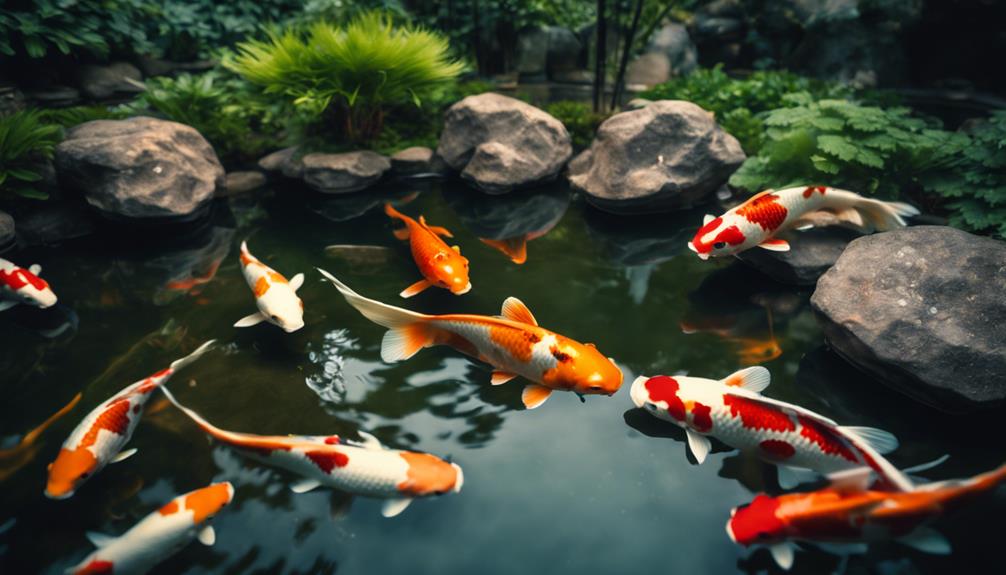
As you shift from hatching to growing and raising koi fish, you'll need to focus on two critical aspects: monitoring their health and providing a balanced diet.
You'll want to regularly check for signs of disease, parasites, or infection, and make adjustments to their environment and nutrition accordingly.
Koi Health Monitoring
You must prioritize koi health monitoring to guarantee your fish thrive in their environment, as it's essential for detecting and addressing potential issues before they become severe.
Regular health checks are pivotal in identifying early signs of diseases, parasites, or infections that can arise from poor water quality.
Regularly test the water for ammonia, nitrite, and nitrate levels to safeguard a safe environment for your koi.
Observe your koi daily for signs of illness or stress, such as labored breathing, lethargy, or changes in appetite or behavior.
Implement preventative measures like vaccinations and parasite control to prevent outbreaks, and quarantine and treat affected fish promptly.
Koi Diet and Nutrition
Proper nutrition plays a vital role in maintaining the health and fertility of your koi fish, making it imperative to provide a balanced diet that meets their unique nutritional requirements.
A high-protein diet is essential for several weeks before breeding to improve fertility. You can achieve this by feeding a mix of live foods, commercial foods, and vegetables.
When it comes to feeding your fry, you'll need to provide small amounts of food several times a day due to their fast metabolism. As they grow, you can increase the amount and frequency of feeding.
A balanced diet that includes a mix of protein, carbohydrates, and fiber is vital for healthy growth and development. You can achieve this by combining commercial pellets, live foods, and vegetables.
Remember to feed your koi 2-3 times a day in small amounts to prevent overeating and swim bladder disorder. Monitor the amount of food you give and remove any excess to maintain ideal water conditions.
Encouraging Koi Spawning Naturally
Create a thriving environment by incorporating underwater plants, which will provide sheltered spots for your koi to spawn and lay eggs, and ultimately support the development of newly hatched fry. This is crucial in encouraging koi spawning naturally. You want to create a breeding environment that mimics their natural habitat, increasing the chances of successful breeding.
Temperature is a key factor, as koi typically spawn when water temperatures are between 65°F to 70°F, usually in late spring or early summer between May and June.
The courtship ritual is another important aspect, where males will chase females, nudging their sides with mouth and fins to encourage egg-laying, and females will lay eggs which are then fertilized by males.
Stress reduction is also essential, as spawning can be a stressful event for koi. Creating a safe and comfortable environment is essential in reducing stress and increasing the chances of successful breeding.
Creating Koi Spawning Areas
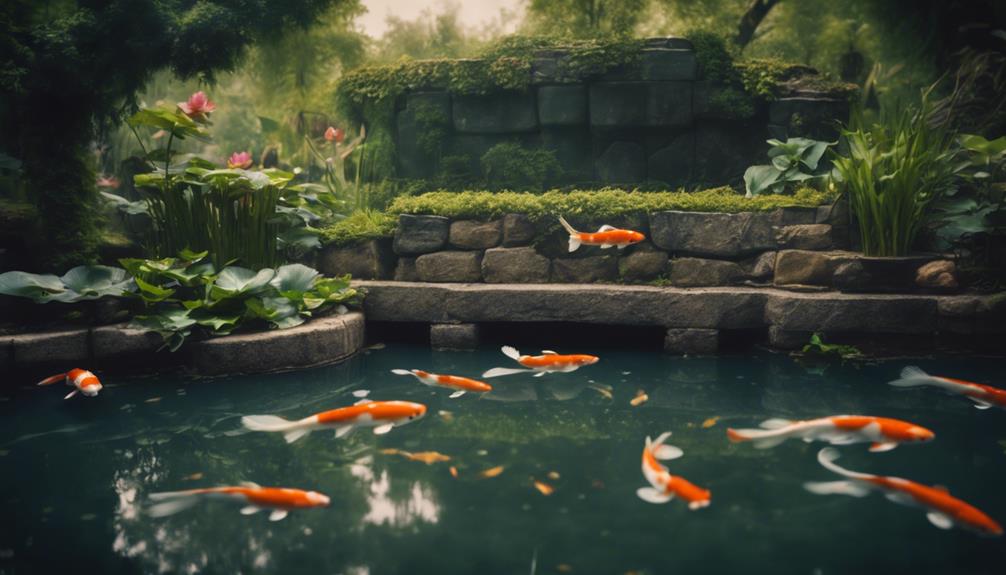
When creating koi spawning areas, you'll want to focus on selecting the right underwater plants to encourage your koi to spawn.
These plants will provide a safe and inviting environment for your koi to lay their eggs.
Underwater Plant Selection
Selecting the right underwater plants is crucial to building a thriving koi breeding pond, as they provide sheltered spawning areas that mimic the natural habitats of these ornamental fish.
When choosing plants for your water garden, you'll want to select species that thrive in underwater environments and can tolerate the water conditions created by your koi.
pH Tolerance: Choose plants that can adapt to the pH levels in your pond, which should be between 6.5 and 8.5 for koi.
Filtration Compatibility: Select plants that won't interfere with your pond's adequate filtration system, ensuring the water remains clean and clear.
Shelter Provision: Opt for plants that provide dense foliage or structural complexity, creating hiding spots and sheltered areas for your koi to spawn and thrive.
Safe Egg-Laying Environments
By incorporating submerged plants and strategically designing your pond's layout, you can craft a safe and inviting environment that encourages your koi to spawn and lay eggs.
Submerged pond plants provide a secure haven for your koi to spawn, and also protect and feed newly hatched fry. To create a safe egg-laying environment, you can place these plants in planting baskets with planting media and oxygenators, allowing plant roots to branch out while containing them.
A safe environment can increase the chances of successful breeding, as koi spawn in response to environmental stimuli, such as water temperature and day length.
With a mix of males and females, a safe environment can help reduce stress and promote healthy breeding. Regular water changes and monitoring of water quality are essential to maintain a safe and healthy environment for koi to spawn and lay eggs.
Managing Pond Water Quality
To guarantee the health and fertility of your koi, you must prioritize managing pond water quality, as it plays a vital role in creating a perfect breeding environment. During the breeding season, it's essential to keep the water clean and free from toxins to facilitate ideal spawning conditions.
Regular water changes are crucial, change 10-20% of the water weekly to remove built-up toxins and prevent ammonia levels from rising.
Remove waste and debris regularly by siphoning or netting out dead eggs or fry to prevent decay and maintain water quality.
Monitor and adjust temperature to keep the water temperature between 68-74°F, as fluctuations can affect koi fertility and spawning.
Additionally, consider using beneficial bacteria like Natures Defense or Muck Defense to break down waste and maintain a healthy ecosystem. You can also use The Pond Guy Stress Reducer Plus to remove chlorine and toxic heavy metals from tap or well water, creating a safer environment for your koi.
Preventing Predation and Disease
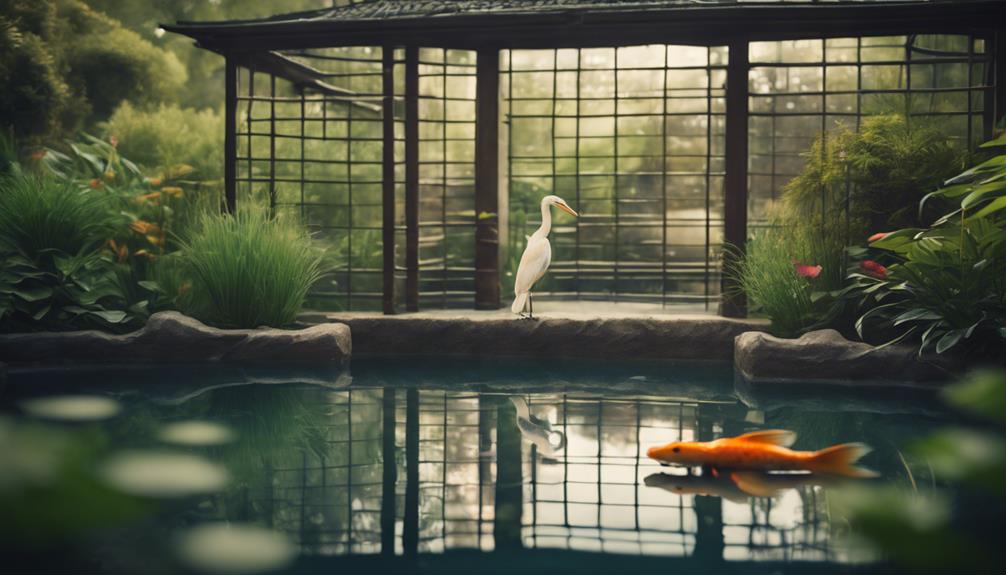
As you've optimized your pond's water quality, now it's time to safeguard your koi from external threats, including predators and diseases that can devastate your breeding program.
To prevent diseases, maintaining a clean and healthy environment is vital.
However, let's focus on protecting your koi from predators that can lurk around the ponds. A fence or netting around the pond is essential to keep predators out, such as raccoons, birds of prey, cats, and herons.
Consider installing electric fencing for added protection, especially against raccoons and cats that can climb or jump.
Regularly inspect the pond's surroundings for signs of predators, like footprints or damaged plants, and take prompt action to prevent attacks.
Keep cats away from the pond, as they can catch small koi or injure larger ones.
Installing motion-activated sprinklers or ultrasonic repellents can also deter predators without harming them.
Caring for Young Koi Fish
With your pond's environment fine-tuned and predators kept at bay, you're now ready to focus on the critical task of nurturing your young koi fish, which requires attention to their specific dietary and habitat needs.
Caring for young koi, also known as fry, is a delicate process that demands precision and attention to detail. From hatching to maturity, koi fish undergo several stages of development, each with unique requirements.
Three essential tips to guarantee the healthy growth of your young koi:
- Provide a varied diet: Fry need a nutrient-rich diet that includes live foods, such as brine shrimp and infusoria, as well as commercial fry food.
- Maintain ideal water conditions: Regularly test and adjust water parameters, such as pH, ammonia, and nitrite levels, to certify a safe and healthy environment for your koi.
- Monitor and separate: Regularly monitor your fry for signs of stress or disease, and separate them into different groups based on size and growth rate to prevent competition and cannibalism.
Maintaining a Balanced Ecosystem
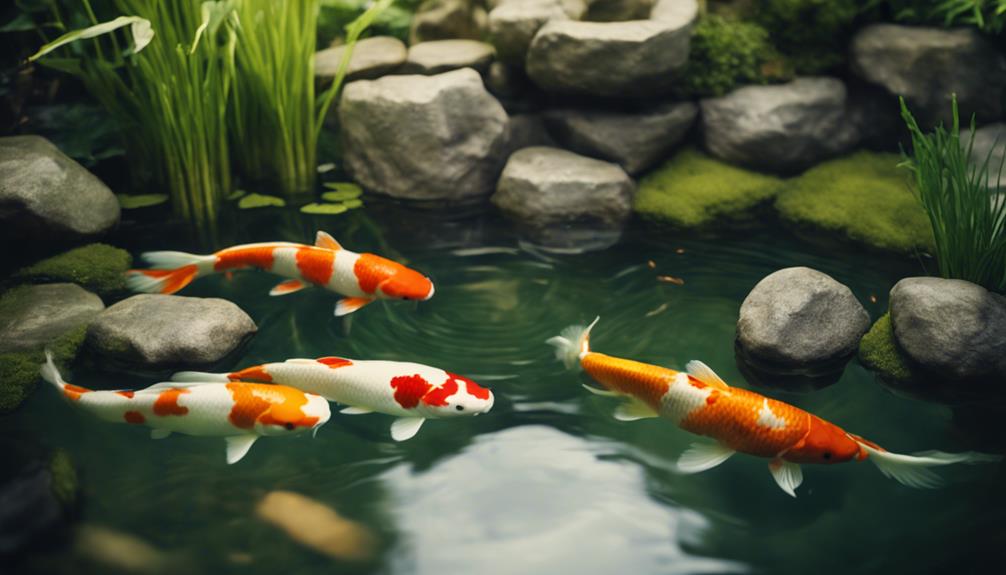
You'll need to meticulously manage your koi breeding pond's ecosystem, guaranteeing it stays balanced and healthy, to support the ideal growth and development of your fish.
A balanced ecosystem requires adequate filtration, aeration, and water flow to maintain superior water quality. Regular water changes, typically 10-20% every week, are necessary to remove waste products and prevent the buildup of toxins that can harm koi.
Introduce beneficial bacteria, such as those found in products like Natures Defense or Muck Defense, to break down waste and maintain a healthy ecosystem.
Additionally, guarantee your pond has sufficient space for koi to move around freely, with a minimum of 1 square foot of surface area per inch of fish.
This will prevent overcrowding and stress, which can lead to disease and poor growth. By maintaining a balanced ecosystem, you'll be able to provide your koi with the best possible environment for growth and development.
Frequently Asked Questions
What Are the Conditions for Koi Breeding?
When you're breeding koi, you'll need to control the climate, guaranteeing 68-74°F water temperatures, while prioritizing fish nutrition with high-protein diets, maintaining superior water quality, and securing your pond to prevent contamination and guarantee a healthy environment.
What Are the Best Conditions for a Koi Pond?
As you create your haven, imagine a harmonious symphony where water quality is the melody, pond aeration is the rhythm, and a balanced fish population is the harmony, all in sync with seasonal changes, allowing your koi to thrive in perfect harmony.
What Is the Best Substrate for a Koi Pond?
When selecting a substrate for your koi pond, you'll want to choose a high-quality gravel with a depth of 2-3 inches, avoiding mud composition and sharp rocks, to create a safe and healthy environment for your fish.
Why Aren't My Koi Fish Breeding?
You're wondering why your koi aren't breeding? It's likely due to fish stress from poor water clarity, overcrowding in your pond, or underlying genetic issues – all of which can disrupt their reproductive cycle and behavior.
Conclusion
Creating a perfect koi breeding pond environment requires attention to detail and dedication.
By following these guidelines, you'll be well on your way to raising healthy, thriving koi.
Did you know that a single koi female can lay up to 100,000 eggs at a time?
With proper care, many of these eggs will hatch and grow into beautiful, vibrant fish.
By maintaining ideal pond conditions and monitoring water quality, you'll be rewarded with a stunning and sustainable koi population.

